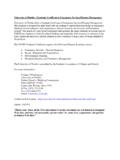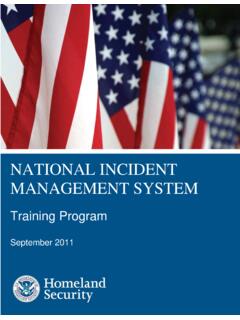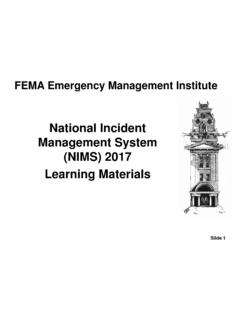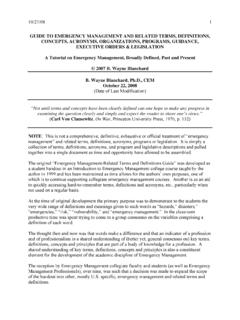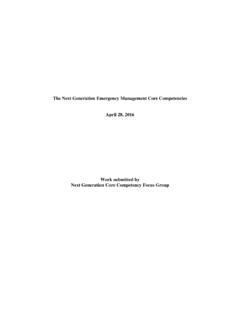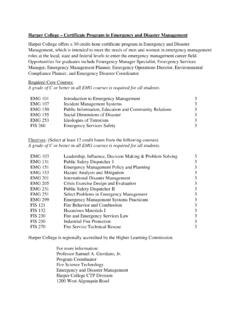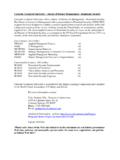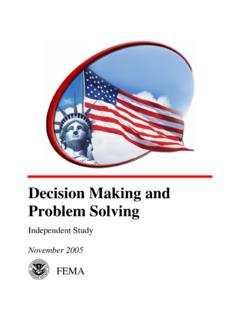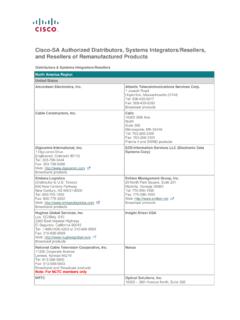Transcription of Defense Support for Civil Authorities (DSCA)
1 X-1 Session X (Instructor to Enter) Course Title: (INSTRUCTOR TO ENTER HERE) Session Title: Defense Support for Civil Authorities (DSCA) Time: 3 h. Objectives: Provide a background overview and brief history of military assistance in international and domestic disaster response and recovery operations. Review the resources available for domestic emergency management, defining engagement types and the role of the United States Northern Command (USNORTHCOM). Discuss DSCA limiting and authorizing provisions and the relationships and engagement opportunities that exist between them. Discuss the process of engagement (command, control, and coordination), and the role of the dual status commander Discuss DSCA Planning Requirements Scope: This session provides an awareness level understanding of civilian-focused planning for military emergency and disaster management Support .
2 During the session, the Instructor will provide a brief history and general overview of DSCA. Basic information on resource availability will be provided as well as the different avenues (types) of engagement, limits on engagement, engagement Authorities , and forms of agreement. The Instructor will provide a lecture on DSCA planning applications for domestic public-sector entities. The session will include exercises that examine DSCA planning in practice. Materials explain the difference between Military Humanitarian Assistance and Disaster Response (HADR) and Foreign Humanitarian Assistance (FHA) operations, but do not provide any detail about foreign disaster assistance. X-2 Readings: Participant Reading: Buchalter, Alice R. 2007. Military Support to Civil Authorities : The Role of the Department of Defense in Support of Homeland Defense ( ).
3 Library of Congress Research Division. February. Department of Defense . 2017. Defense Support of Civil Authorities : DoD Incident Response. DoD Manual Volume 2 ( ). April 12. Department of the Army. 2013. Defense Support of Civil Authorities . ADRP 3-28 ( ). June. Homeland Security National Preparedness Task Force. 2006. Civil Defense and Homeland Security: A Short History of National Preparedness Efforts ( ). Department of Homeland Security. September. Northern Command. n/d. A Short History of United States Northern Command ( (current%20as%20of%20 March%202014).pdf). Northern Command, Office of History. Instructor Reading: Buchalter, Alice R. 2007. Military Support to Civil Authorities : The Role of the Department of Defense in Support of Homeland Defense ( ). Library of Congress Research Division. February. Department of Defense .
4 2017. Defense Support of Civil Authorities : DoD Incident Response. DoD Manual Volume 2 ( ). April 12. Department of the Army. 2013. Defense Support of Civil Authorities . ADRP 3-28 ( ). June. Homeland Security National Preparedness Task Force. 2006. Civil Defense and Homeland Security: A Short History of National Preparedness Efforts ( ). Department of Homeland Security. September. Northern Command. n/d. A Short History of United States Northern Command ( (current%20as%20of%20 March%202014).pdf). Northern Command, Office of History. X-3 General Requirements: Provide lectures and facilitate class and group discussions. Distribute handout materials for reference and for class and group discussions. Objective : Provide a background overview and brief history of military assistance in international and domestic disaster response and recovery operations.
5 Requirements: Provide a lecture that introduces the Department of Defense (DoD) as a member of the Government emergency management stakeholder community and explains in general terms the role that the Military has played in domestic and international disaster risk management operations throughout history and leading up to present times. Facilitate class and group discussions. Remarks: I. The Instructor can introduce the Session topic by leading a class discussion on the role of the Department of Defense . A. This can begin with a general overview of the Department and then increase the focus to explain how emergency and/or disaster response functions fit within this context. B. The discussion will help to ensure a baseline understanding of Defense Support of Civil Authorities (DSCA) exists among the participant audience whose members may have vastly differing and perhaps conflicting knowledge and preconceptions about the topic.
6 C. The overview should include a presentation of the major military commands and the military chain of command. The Instructor may draw from the following: 1. The Department of Defense (DoD) is the United States oldest and largest Federal entity. a) It is a massive department that manages, directs, and supports a vast inventory of uniformed military enlisted troops and officers, base facilities, weapons and weapons systems, vehicles, equipment, and other national Defense resources. It also oversees thousands of civilian forces and employees. X-4 b) The DoD mission is direct, succinct, and reads as follows (Slide ): [T]o provide a lethal Joint Force to defend the security of our country and sustain American influence abroad. ( , 2018). c) Over million men and women currently serve in the military on active duty. An additional 742,000 civilian personnel also work for the department, as well as approximately 826,000 Americans serve in the National Guard and Reserve Forces.
7 Together, these people make the DoD the nation s largest employer. d) To ensure security of the United States and maintain worldwide operational readiness, DoD maintains Defense installations and facilities in every time zone and in every climate. This includes over 5,000 individual locations in the United States and abroad. More than 450,000 DoD employees serve overseas at any given time, whether at sea or on land. 2. The Armed Forces consists of five separate branches, which include (Slide ): a) The United States Army b) The United States Air Force c) The United States Navy d) The United States Marine Corps e) The United States Coast Guard 3. However, these branches are functionally organized within three military departments, and in the case of the Coast Guard, under the Department of Homeland Security. 4. The three departments within the Department of Defense include (Slide ): a) Department of The Army (1) Currently operating in 50 countries, the Army s primary objective is to defend the land mass of the United States, its territories, commonwealths, and possessions.
8 (2) There are two distinctive and equally important components active and reserve. X-5 (3) The reserve component includes the Army Reserve and the Army National Guard. There are approximately 200,000 reservists. b) Department of The Navy (1) The Navy maintains, trains, and equips combat ready maritime forces capable of winning wars, deterring aggression, and maintaining freedom of the seas. (2) The Navy Reserve has approximately 110,000 reservists. (3) The Marine Corps, which is primarily an amphibious force, is actually part of the Department of the Navy and therefore not a unique military department. (4) The Marine Corps provides fleet marine forces with supporting air components for service in the seizure or Defense of naval bases and land operations that may be essential to a naval campaign. (5) The Marine Corps Reserve is the largest command in the Marine Corps, with approximately 38,500 reservists.
9 C) Department of The Air Force (1) The Air Force provides a rapid and flexible air and space capability and routinely participates in peacekeeping, humanitarian and aeromedical evacuation missions. (2) Reserve components of the Air Force include the Air National Guard and the Air Force Reserve. The Air Force Reserve has approximately 82,000 reservists. (3) The Civil Air Patrol is a Congressionally-chartered, Federally-supported nonprofit corporation that serves as an auxiliary of the Air Force and maintains a DSCA role. d) The primary job of all three military departments is to train and equip their personnel to perform warfighting, peacekeeping and humanitarian/disaster assistance tasks. (DoD101, 2018) 5. The management of DoD resources is centralized at the Pentagon but carried out by nine individual combatant commands (abbreviated CCMDS, but also sometimes as COCOMs ).
10 Six of these have geographic responsibility, and three have worldwide responsibility. The nine CCMDs include (Slide ): X-6 a) Central Command (USCENTCOM) (1) Based out of Florida, USCENTCOM is one of the largest military coalitions in history with 34 national flags. (2) It was formed after 9/11 and its purpose is to fight terrorism. (3) Area of Responsibility (AOR) includes parts of southwest Asia, the Middle East and Egypt. b) Indo-Pacific Command (USINDOPACOM) (1) The largest geographic command with an AOR that includes 36 nations in the Asia-Pacific region, USINDOPACOM s purpose is to promote security, encourage peaceful development, deter threats, and respond to contingencies such as Disaster Relief after the 2011 tsunami in Japan. (2) USINDOPACOM, which was called USPACOM until 2018, is based in Aiea, Hawaii, and was established in 1947.
